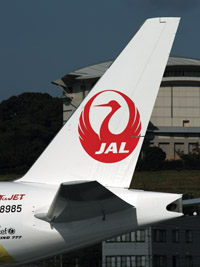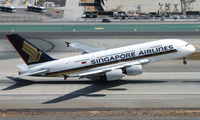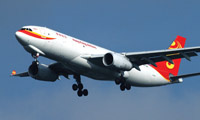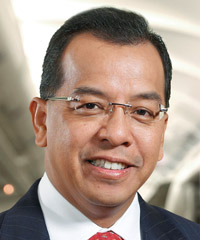Year End Review: Overview
Stars among the gloom
The second coming of Japan Airlines and the continued success of Garuda Indonesia contrasted with the best forgotten year of majors like SIA, Cathay and Qantas.
December 1st 2012
The year started with a warning. “Brace, Brace’ read the headline in the February issue of Orient Aviation. “Industry preparing for another hit on profits,” said the sub-head. Read More »
 |
| Japan Airlines: reborn |
And it was true as major carriers like Singapore Airlines (SIA), Cathay Pacific Airways and Qantas Airways saw their profits eroded big time during 2012. For Qantas’ international arm it was a time of crisis as Virgin Australia (formerly Virgin Blue) and, in particular, a flood of extra seats from Chinese and Middle Eastern carriers entered the market.
After much speculation about a tie-up, this led to an announcement in September that once deadly rivals, Qantas and Emirates Airline, were to establish a 10-year alliance, Australia’s competition watchdog willing that is.
If the green light is given to the alliance by the Australian Competition and Consumer Commission (ACCC) – a final decision is expected in March – it will mean that Qantas will hub its Kangaroo Route to Europe through Dubai and not Singapore, as it has done for decades.
Emirates president, Tim Clark, heralded the move as a “seismic” shift for the airline industry. Qantas boss, Alan Joyce, said the consequences for the Australian icon would be dire if the partnership did not proceed.
All the above happened in the face of ongoing uncertainty about market conditions and no let-up in high oil prices.
But it wasn’t all doom and gloom in the Asia-Pacific. For a start, if airlines were struggling in the region, they were doing far worse elsewhere in the world. The Asia-Pacific continues to be the highest achiever in the world aviation market.
On an individual level, it was impossible to ignore the remarkable transformation of Japan Airlines (JAL). In January 2010, it entered bankruptcy protection and was struck off the rolls of the Tokyo Stock Exchange (TSE).
In the months that followed about a third of JAL’s workforce disappeared. Its gas guzzling aircraft, including its B747s – JAL once had the largest fleet of B747s in the world – were taken out of service and routes slashed. Indeed it has reduced international seat supply by 40% and domestic seat supply by 30% since 2008.
 |
| Singapore Airlines: profits slump, pilots asked to take voluntary unpaid leave |
Under the leadership of management guru, Kazuo Inamori, the founder of hi-tech company, Kyocera, who was drafted in by the Japanese government, the JAL miracle started to happen.
Inamori had been scathing of the previous airline management. He dismissed them as “unfit to run a fruit and vegetable stall”. But those around him now were oiling the wheels of an increasingly efficient machine.
From entering bankruptcy protection and exiting in March this year, raising $8.5 billion in the world’s second largest initial public offering and re-listing on the TSE as the world’s most profitable airline in September, the process took just 973 days.
It may have had some help from a government bail-out, as its illustrious Japanese rival, All Nippon Airways (ANA), continues to remind the industry. It claims the bail-out was “unfair”. The government, for its part, has said it will keep an eye on the situation to see if the aid “has distorted the circumstances of competition”.
But JAL is leaner and meaner than ever. In October the JAL Group announced a US$1.24 million interim profit to March 31 this year. This was 2.3% up on the previous year and prompted the company to increase its full-year net profit forecast by 10 billion yen to 140 billion yen.
Another success story this year has been Garuda Indonesia. In November it reported a 51.9% rise in net income to $56.5 million for the first nine months of 2012, from $37.2 million a year earlier.
Income from operations more than doubled to $92.75 million, compared with $38.6 million in 2011.
 |
| Hong Kong Airlines: fleet expansion frozen by authorities because of safety fears |
And while other legacy airlines in the region suffered, particularly with cargo volumes, Garuda showed improvements on all fronts; passenger and cargo volumes, load factors and yields.
Garuda and its low-cost subsidiary, Citilink, will have had 20 new aircraft join their fleets by the end of the year. Another 34 planes will become part of the combined fleet in 2013.
Garuda’s president, a former banker, Emirsyah Satar, has worked wonders for his airline in recent years (he was Orient Aviation’s Person of the Year in 2010) and, it appears, he has no intention of risking that success by merging with Indonesia’s lost-cause carrier, Merpati Nusantara.
There had been reports in mid-year that the government wanted to see them come together. But Satar left Orient Aviation in no doubt of his intensions when he told the magazine in July: “We are letting them solve their own issues.
“It doesn’t make sense [the merger]. We won’t do it. I have told the government several times: we are a listed company. We just can’t go in there and bail them out. It has to be on a commercial basis.”
Merpati lost $81 million last year and nearly half that amount again in the first four months of 2012. Of its 124 domestic routes, 112 are losing money. According to the Indonesian government, Merpati is bleeding $250,000 a day. You don’t need to be a banker to sympathise with Satar’s view.
Hong Kong Airlines likes to talk the talk, but so far, in its less than glorious history, it has failed to walk the walk.
Owned by Mainland China interests, including its fourth largest carrier, Hainan Airlines, Hong Kong Airlines is based in the Special Administrative Region that bears its name.
 |
| Garuda Indonesia president, Emirsyah Satar: under his leadership, Garuda has deen one of the few success stories in 2012 |
In January, its president, Yang Jianhong, said the carrier intended to establish businesses across the aviation and tourism spectrum, including hotel development, ground handling and air cargo management.
It was planning to bid for a hotel site in Hong Kong, was aiming to acquire a 40% holding in Hong Kong Air Cargo Terminals, establish joint venture flight catering and IT companies at the Hong Kong airport and build a flight training facility.
But so far nothing has happened, at least none of the above. The carrier has a slew of aircraft on order, including 10 A330s, 30 A320s and 15 A350-900 XWBs. The carrier was also at the point of signing for six A380s until China stepped in and said no, in protest over the European Union’s emissions trading scheme, which China refuses to recognize.
Alas, in mid-year Hong Kong Airlines had its fleet expansion frozen by the Hong Kong Civil Aviation Department (CAD). The CAD said it would not be able to add to its 21-aircraft fleet without permission because the CAD had concerns about the safety of the airline.
The one thing Hong Kong Airlines did achieve this year was launch an all business A330 daily service between Hong Kong and London in March. But this was cancelled in September. With little demand it was said to be losing $1.3 million a month.
Hong Kong Airlines also put an initial public offering it had planned on hold.
Back in February, Malaysia Airlines (MAS) chief executive, Ahmad Jauhari Yahya, wasn’t pulling his punches. “The company is in crisis,” he said.
Appointed to lead the airline in September, 2011, he launched a tough business plan in December and said MAS had “to stem the losses before going forward”. One year on there are signs the plan is working.
In November, Yahya told Orient Aviation that the first six months of 2012 had been “encouraging”. Losses were down over 30% on 2011 and the airline made a small operating profit of $194,000 in June.
 |
| Qantas Airways CEO, Alan Joyce: “dire consequences” for airline if partnership with Emirates does not go ahead |
These figures, said the CEO, reflected the value of his decision to cut 12 loss-making routes, which meant an 8% capacity reduction from the network.
A major re-fleeting exercise is also underway. By the end of 2012, 23 aircraft will have been delivered, including four of six A380s it ordered. Older aircraft are being retired.
However, there must have been disappointment in the board room that the share swap and alliance with AirAsia did not work out following protests from the MAS unions (see low-cost carriers).
One of the more interesting fleet order announcements this year was from Philippine Airlines (PAL). Not for the fact that it ordered a record 54 new jets, but that airline president, Ramon Ang, chose the moment to tell assembled media that PAL was hoping to build its own airport (see airports).
At its annual general meeting held in Beijing, in July, the International Air Transport Association (IATA) re-iterated the new-year forecast: gloom and more gloom.
Industry profit was expected to slump to $3 billion this year after reaching a record $15.8 billion three years ago. The good news was that the Asia-Pacific would account for two thirds of those profits.
It didn’t exactly have the likes of the region’s major legacy carriers, SIA, Cathay Pacific and Qantas, jumping up and down.
In August, Cathay reported its worst interim result since 2003 when Hong Kong passenger numbers were decimated by SARS (Severe Acute Respiratory Syndrome).
It reported a loss of $120 million in the six months to June 30, compared with a $359 million profit in 2011. This followed a 61% fall in full-year profits for 2011. The carrier suffered from the predictable factors; high jet fuel costs, low passenger yields and particularly weak air cargo demand.
During the course of this year, Cathay parked three B747-400s and three B747-400 BCF freighters to cut costs. Flight crews at Cathay and its wholly-owned subsidiary, Dragonair, were offered unpaid voluntary leave.
In June, Cathay ordered 10 A350-1000s and agreed to convert orders for 16 A350-900s to 1000s in a deal worth $4.2 billion.
In the same month Qantas announced an annual loss of $258 million to June 30, its first deficit since the airline was privatized in 1995.
The loss prompted chief executive, Alan Joyce, to report that the national carrier was cancelling orders for 35 B787-9s, which had been due for delivery post 2014. More recently it announced it is cutting a net 400 jobs from its engineering bases in Australia.
Meanwhile, SIA saw its interim profits slump 30% to $137.8 million compared with the same period in 2011.
In March, in an attempt to cut costs, SIA asked its pilots to volunteer for unpaid leave. And in November the carrier announced it would be parking one of its 13 freighters from January 2013 until May the following year (see freight).
In October, SIA announced it would be ceasing the world’s longest non-stop flights between Singapore – Los Angeles and Singapore – Newark next year and selling the five A340-500s it used for the services back to Airbus.
However, on the same day, the carrier announced orders for five more A380s – it has 19 in service – and 20 A350-900s to add to an earlier order for 20 A350s, worth $7.5 billion at list prices.
Air New Zealand also felt the cold wind of the world recession this year and by mid-year had shed 441 jobs, 175 through redundancies and the remainder by attrition.
| In brief: * Major overseas aerospace companies continued to pump millions of dollars into Singapore during 2012 with the Lion City’s ‘crown jewel’ Seletar Aerospace Park, growing apace. Rolls-Royce opened its 154,000 sq metre manufacturing, assembly, training and research campus at the park in February. When fully operational it will provide 500 new jobs bringing the total of people employed by Rolls-Royce and its joint ventures in Singapore to 2,000. |